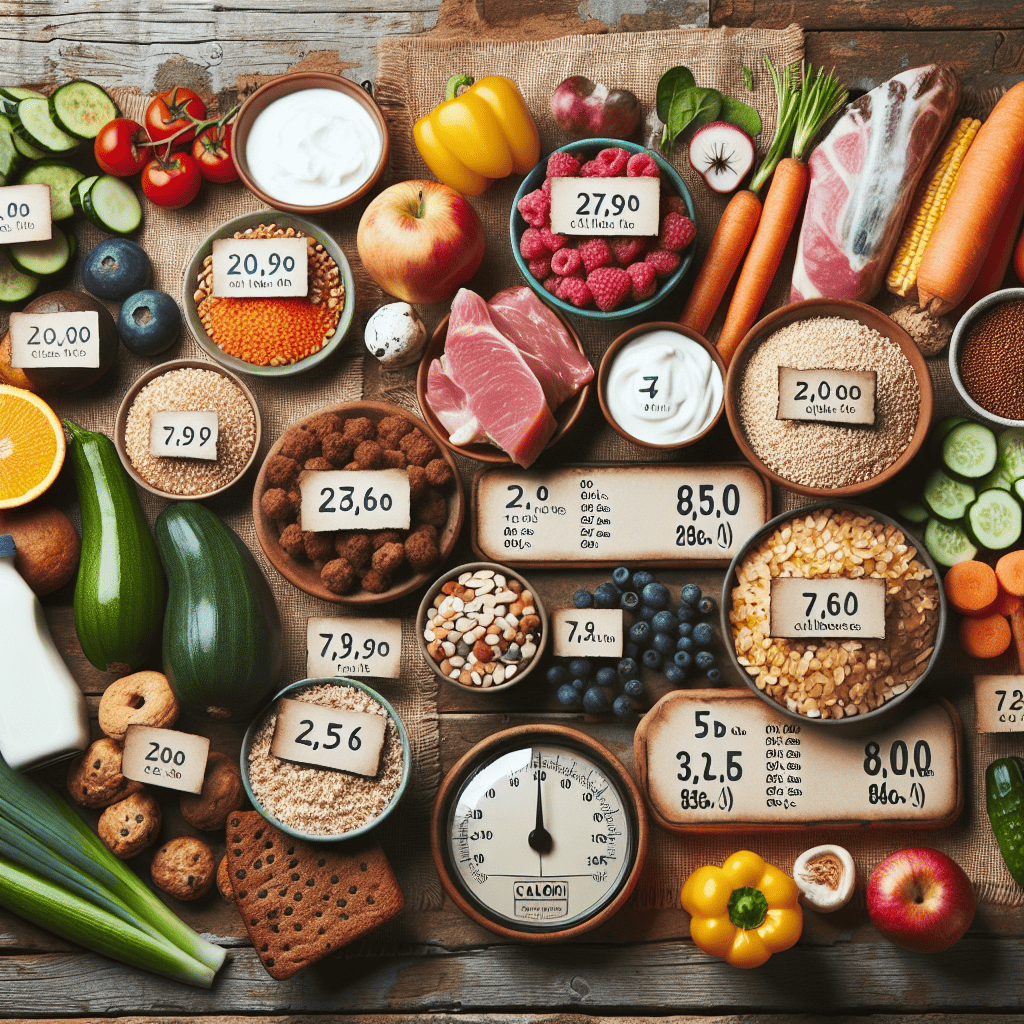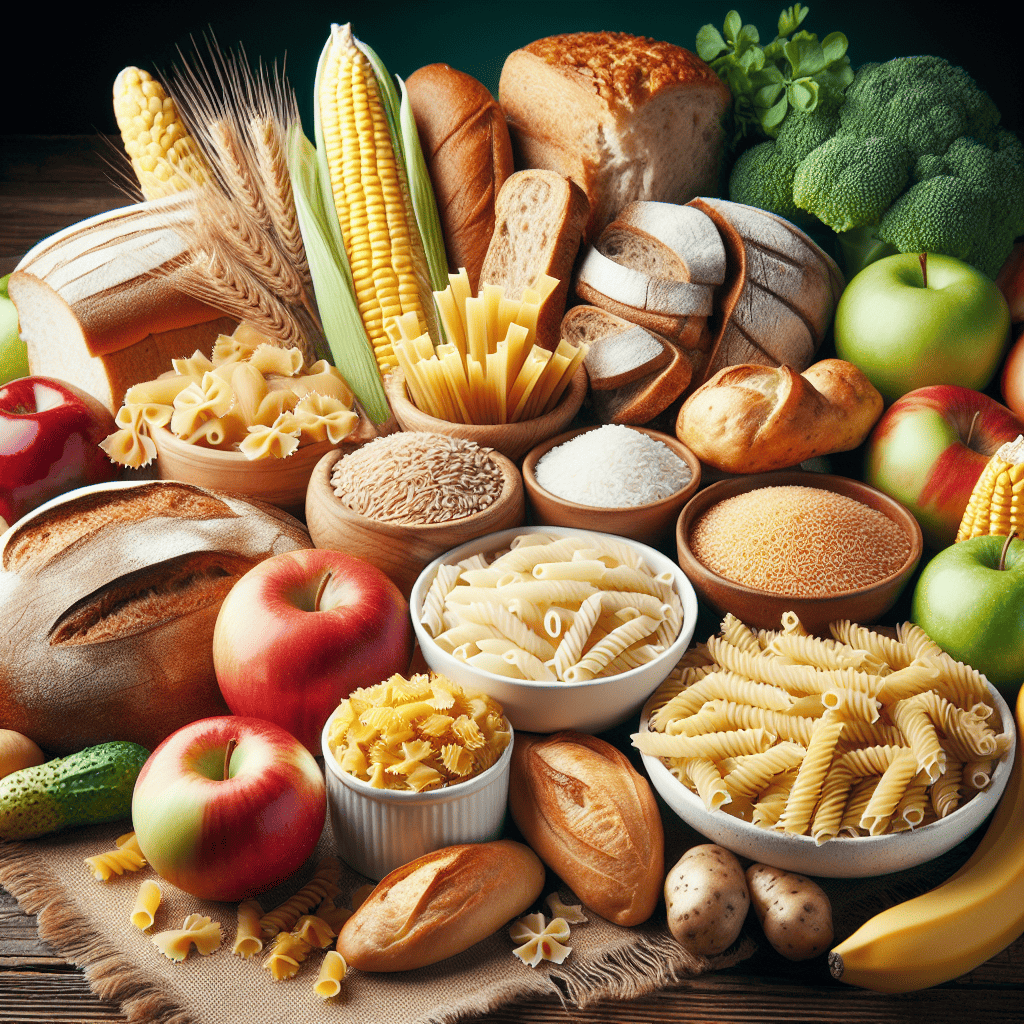Introduction: Understanding how to calculate the calorie content of food is vital for maintaining a healthy diet. This article delves into the process of determining calories in different food groups and provides practical examples for readers to comprehend the importance of calorie measurement in their daily nutritional intake.
Table of Contents
Food Groups and Calories
Learn about the calorie content of various food groups to make informed choices for a balanced diet.
- Starches and Bread:
Starches, such as bread, rice, pasta, and potatoes, are rich sources of carbohydrates. Carbohydrates are the body’s primary source of energy and play a crucial role in fueling various bodily functions. When consumed, carbohydrates are broken down into glucose, which is used by the body for immediate energy or stored in the muscles and liver as glycogen for future use. Each gram of carbohydrate provides around 4 calories, which is why starchy foods like bread are considered essential for meeting the body’s energy requirements.
Understanding the calorie content of starches and bread is important for managing weight and maintaining a healthy diet. By knowing that 1 gram of starch or bread provides 4 calories, individuals can make informed decisions about portion sizes and meal composition. In today’s world where overconsumption of calories is a prevalent issue leading to obesity, being mindful of the caloric content of foods like bread allows individuals to balance their intake and avoid excessive calorie consumption. Additionally, balancing starch intake with other food groups like protein, fruits, and vegetables is crucial for a well-rounded and nutritious diet.
Incorporating starches and bread in a balanced meal plan is advantageous not only for meeting energy needs but also for supporting overall health. Whole grain bread, brown rice, and whole wheat pasta are excellent sources of fiber, vitamins, and minerals in addition to providing energy. Fiber, in particular, is important for digestive health and helps in maintaining a feeling of fullness which can aid in weight management. By including a variety of starches and bread in meals, individuals can ensure they receive a diverse range of nutrients while meeting their calorie requirements for the day.
- Meats and Legumes:
Proteins from meats and legumes are essential nutrients required for various bodily functions. Meats such as chicken, turkey, and lean cuts of beef are excellent sources of protein and are relatively low in calories. For example, lean meats provide around 56 calories per ounce, making them a great option for those looking to increase their protein intake without consuming excessive calories. These meats also contain essential amino acids that the body needs to build and repair tissues, making them a valuable addition to a balanced diet.
On the other hand, legumes like beans, lentils, and chickpeas also offer a significant amount of protein along with fiber, vitamins, and minerals. While legumes have a slightly higher calorie content compared to lean meats, they make up for it by providing a good mix of nutrients. The fiber in legumes not only aids digestion but also helps in keeping you feeling full for longer periods, which can be beneficial for weight management. Additionally, the protein content in legumes is essential for muscle growth and repair, making them a popular choice among vegetarians and vegans looking to meet their protein needs.
Choosing between lean meats and legumes often depends on individual dietary preferences and nutritional goals. While lean meats are lower in calories and high in protein, making them ideal for those focused on weight control and muscle building, legumes offer a plant-based source of protein with added fiber and nutrients. Incorporating a variety of both lean meats and legumes into your diet can ensure that you are meeting your protein requirements while also benefiting from the unique nutrients each food group has to offer.
- Non-starchy Vegetables:
Non-starchy vegetables are an essential component of a healthy diet due to their low-calorie content and high nutritional value. These vegetables, such as leafy greens, bell peppers, broccoli, and tomatoes, are packed with essential vitamins, minerals, and antioxidants that are vital for overall health. By including a diverse range of colorful vegetables in your meals, you can ensure that you are getting a wide array of nutrients without consuming excess calories. This is particularly beneficial for individuals looking to manage their weight or improve their overall health.
In addition to being nutrient-dense, non-starchy vegetables are also rich in fiber, which is important for maintaining a healthy digestive system and promoting satiety. Fiber helps to regulate digestion, prevent constipation, and support a healthy gut microbiome. By adding a variety of non-starchy vegetables to your diet, you can increase your fiber intake, which can have a number of positive health benefits. Furthermore, the fiber content in these vegetables can help you feel fuller for longer periods, which may aid in weight management by reducing overall calorie intake.
Moreover, the vibrant colors of non-starchy vegetables are indicative of the various phytochemicals they contain, which have powerful antioxidant properties. These antioxidants help to protect the body from oxidative stress and inflammation, reducing the risk of chronic diseases such as heart disease, diabetes, and certain types of cancer. By regularly consuming a rainbow of non-starchy vegetables, you can support your immune system, improve your skin health, and reduce the risk of developing various health conditions. Therefore, incorporating a variety of non-starchy vegetables into your meals is a simple yet effective way to boost your overall health and well-being.
Substitutes in Each Food Group
Discover alternative options within food groups for a balanced and varied diet.
- Starches and Bread:
When looking to diversify carbohydrate intake, exploring substitutes like quinoa, sweet potatoes, or whole-grain alternatives can offer a variety of nutritional benefits. Quinoa, for instance, is a gluten-free whole grain that is also a complete protein, containing all nine essential amino acids. It is a great option for those looking to increase their protein intake while still consuming carbohydrates. Quinoa is also high in fiber, which can aid in digestion and help with achieving a feeling of fullness. Moreover, it is rich in vitamins and minerals, such as magnesium, iron, and zinc, making it a nutritious choice to incorporate into meals.
Sweet potatoes are another excellent substitute for traditional starches like white potatoes. They are not only delicious but also packed with nutrients. Sweet potatoes are a good source of vitamin A, which is important for eye health and immune function. They are also rich in fiber and antioxidants, helping to reduce inflammation and protect against chronic diseases. Additionally, sweet potatoes have a lower glycemic index compared to white potatoes, meaning they cause a slower and steadier increase in blood sugar levels, making them a suitable option for those watching their blood sugar levels.
Whole-grain alternatives to traditional bread can provide more fiber, vitamins, and minerals. Whole grains like whole wheat, oats, barley, and rye contain the entire grain kernel, including the bran, germ, and endosperm, which preserves the nutrient content. This can help improve heart health, regulate blood sugar levels, and support digestive health. Whole grains can also keep you feeling fuller for longer periods due to their high fiber content, reducing the likelihood of overeating. When selecting whole-grain bread, it is essential to look for options labeled as ‘100% whole grain’ or ‘100% whole wheat’ to ensure you are getting the full nutritional benefits.
- Meats and Legumes:
Plant-based substitutes such as tofu, tempeh, and lentils offer numerous benefits beyond just reducing calorie intake and increasing fiber content. Tofu, for example, is made from soybeans and is an excellent source of protein, essential amino acids, iron, and calcium. It is a versatile ingredient that can be used in various dishes, from stir-fries to smoothies, making it a popular choice for vegetarians and vegans. Tempeh, another soy-based product, is fermented, which enhances its digestibility and nutrient absorption. It is rich in probiotics, which can promote gut health and improve digestion. Additionally, tempeh has a unique nutty flavor and a firm texture, making it a great alternative to meat in sandwiches, salads, and stir-fries.
Lentils, on the other hand, are a type of legume that is high in fiber, protein, and various vitamins and minerals. They are a versatile ingredient that can be used in soups, stews, salads, and curries. Lentils are also a good source of folate, which is important for pregnant women to support fetal development. By incorporating lentils into your meals, you can increase your fiber intake, which can help improve digestion, regulate blood sugar levels, and promote satiety, ultimately aiding in weight management. Moreover, lentils are relatively inexpensive and have a long shelf life, making them a convenient and budget-friendly option for those looking to add more plant-based foods to their diet.
Overall, opting for plant-based substitutes like tofu, tempeh, and lentils can not only help reduce calorie intake and increase fiber content but also provide a wide range of nutrients that are essential for overall health and well-being. These plant-based options are environmentally friendly, as they have a lower carbon footprint compared to animal products, making them a sustainable choice for those looking to reduce their impact on the environment. By incorporating these ingredients into your diet regularly, you can enjoy the benefits of a more diverse and nutrient-rich eating pattern while also supporting your health, the planet, and animal welfare.
Illustrative Example of Calculating Calories in Food
Follow a practical example to understand how to calculate the calorie content of common meals for effective nutritional planning.
- Breakfast Example:
A typical breakfast meal consisting of oatmeal, fruit, and yogurt is not only a popular option but also a nutritious and well-balanced choice. Oatmeal, a whole grain, is high in fiber and complex carbohydrates, providing long-lasting energy and keeping you full for an extended period. Additionally, oatmeal contains essential minerals such as iron and magnesium, promoting overall well-being. A half-cup serving of cooked oatmeal typically amounts to around 150 calories.
Fruits are an excellent addition to any breakfast meal as they are packed with vitamins, minerals, and antioxidants. For instance, a medium-sized banana contains approximately 100 calories and is a good source of potassium, which is essential for muscle function and fluid balance in the body. Combining the oatmeal with a serving of fruit like blueberries or strawberries adds natural sweetness and additional nutrients to the meal, without significantly increasing the calorie count.
Yogurt, especially Greek yogurt, is another staple in a balanced breakfast. It is rich in protein, calcium, and probiotics, supporting gut health and aiding in muscle recovery and growth. A typical serving of Greek yogurt provides about 100-150 calories, depending on the brand and fat content. By adding a serving of yogurt to the oatmeal and fruit, you create a well-rounded breakfast that includes complex carbohydrates, protein, vitamins, and minerals, making it a satisfying and nutritious start to the day. When considering the entire meal of oatmeal, fruit, and yogurt, the total calorie content usually ranges from 350 to 500 calories, depending on portion sizes and specific ingredients chosen. This nutritious breakfast not only provides essential nutrients but also ensures a good balance of macronutrients, including carbohydrates, proteins, and fats, setting a positive tone for the day ahead.
- Lunch Example:
When calculating the calorie content of a balanced lunch consisting of grilled chicken, salad, and whole-grain bread, it is important to consider the individual components. Grilled chicken is a lean source of protein and is generally low in calories compared to other protein options like fried chicken. A typical serving of grilled chicken breast, around 3 ounces, contains approximately 120-150 calories depending on the cooking method and any added oils or marinades during grilling.
Next, the salad, depending on the ingredients and dressing used, can vary in caloric content. A salad made primarily of leafy greens like spinach or mixed greens will be low in calories but highly nutritious due to the fiber and vitamins they provide. Adding vegetables like tomatoes, cucumbers, and bell peppers will increase the volume of the salad without significantly adding to the calorie count. However, it is important to be mindful of high-calorie additions like croutons, cheese, nuts, seeds, and creamy dressings, as they can quickly elevate the calorie content. Opting for a light vinaigrette dressing or a squeeze of lemon juice can keep the salad light and refreshing without unnecessary calories.
Finally, whole-grain bread is a good source of complex carbohydrates and fiber, which can help provide sustained energy throughout the afternoon. When selecting whole-grain bread for the lunch, it is important to pay attention to portion sizes to manage calorie intake. A typical slice of whole-grain bread contains around 70-100 calories. Choosing a modest portion like one or two slices can complement the grilled chicken and salad without drastically increasing the overall calorie count of the meal. By balancing the portions of grilled chicken, salad, and whole-grain bread while being mindful of high-calorie add-ons, it is possible to create a satisfying and energizing lunch that falls within desired calorie limits.
How to Measure Food Rations
Master the art of measuring food quantities accurately for precise calorie tracking and portion control.
- Using Weighing Scales:
When using a kitchen scale to weigh ingredients, it is important to first ensure that the scale is properly calibrated. This can usually be done by pressing the tare or zero button to reset the scale to zero before placing any ingredients on it. Each ingredient should be weighed individually for accuracy. Place the bowl or container on the scale, press the tare button to zero it out, then add the ingredient until you reach the desired weight. This method provides a more precise measurement compared to using volumetric measurements like cups and tablespoons, which can vary based on how ingredients are packed or heaped.
Calculating accurate calorie counts for recipes and meal planning involves weighing each ingredient in the recipe with a kitchen scale and then referring to a reliable calorie database or food labeling to determine the number of calories per gram for each ingredient. After weighing each ingredient, multiply the weight of each ingredient by its calorie count per gram and then sum the total to get the overall calorie count for the recipe. This method allows for more accurate tracking of calorie intake compared to using generic measurements, which can lead to inaccuracies in estimating portion sizes and calorie content.
Using a kitchen scale for weighing ingredients and calculating calorie counts not only helps in ensuring the accuracy of recipes but also aids in portion control and weight management. By knowing the exact amount of each ingredient going into a dish, you can have better control over the nutritional content of your meals. Additionally, being mindful of portion sizes and calorie counts can support overall health and wellness goals, whether it be maintaining a healthy weight, managing specific dietary needs, or tracking macronutrient intake. With the precision offered by a kitchen scale, you can make more informed decisions about your food choices and tailor your meals to meet your individual nutritional requirements.
- Measuring Cups and Spoons:
Measuring cups and spoons play a crucial role in maintaining portion sizes and controlling calorie intake, especially when it comes to cooking or baking. For liquids, using a measuring cup ensures precision in the quantity of liquid being added to a recipe. This accuracy is essential as even a slight variation in the amount of liquid can affect the consistency and overall outcome of the dish. Whether it’s water, oil, milk, or any other liquid ingredient, using a measuring cup helps in following the recipe correctly and achieving the desired results.
When it comes to dry ingredients like flour, sugar, or spices, measuring cups and spoons are equally important. Overfilling a measuring cup with flour, for example, can lead to using more flour than needed, resulting in a denser and drier end product. On the other hand, using too little of a dry ingredient can alter the taste or texture of the dish. By using measuring cups and spoons for dry ingredients, you can ensure consistency in your recipes and have better control over the calorie content of your meals.
In addition to maintaining portion sizes and controlling calorie intake, using measuring cups and spoons can also help in reducing food waste. By accurately measuring the ingredients needed for a recipe, you are less likely to end up with excess food that might go to waste. This practice not only saves money but also promotes sustainability by minimizing the amount of food that gets thrown away. Therefore, incorporating the use of measuring cups and spoons in your cooking routine is not only beneficial for your health and calorie intake but also for your wallet and the environment.




